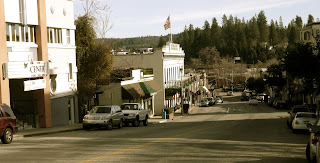California’s State Route 20 to Nevada City
Sometimes traveling east or west
between San Francisco/Sacramento and Reno/Truckee, we just have to get there
now. So we mount up and rocket
over the Sierra on Interstate 80.
A freeway, I-80 is designed for people in a hurry – and big trucks.
A pleasant alternative, and a “must do” for folks who may
pass this way but once involves California’s state route 20. This little gem departs I-80 about 20
minutes west of Truckee and by hooking in with CA 49 at Nevada City, thence to
Auburn, adds only about an ninety minutes to the trip. That is, if you don’t stop and if
you’re not enticed to explore.
A late April day in the Sacramento area felt more like
summer than spring. A trip to
elevation seemed in order. I
mounted Aria, the Moto Guzzi Breva – what
a fun bike that is! – and headed east to enjoy this favored route. After stopping at Brunswick, between
Grass Valley and Nevada City for breakfast I zipped all the twenty-seven
sweeping miles Highway 20 offered before it conflues with I-80. There, I U-turned, retracing the route,
pausing for pictures and sojourns along the way.
West of the interchange, CA 20 slips
downward into the drainage of the Bear and Yuba Rivers.
Bowman Lake Road offers a nice dalliance into the basaltic
northern high Sierra. A nicely
engineered Sierra Discovery Trail begs one to stop and investigate the upper
reaches of the Bear.
Although here, it is more of a brook than a river.
Further up this side trip, we cross the more robust South
Yuba. I turn back at this point
knowing what the road will become aware that the dual-sport is resting in the
garage.
The area is bisected with flumes dating back to the gold
rush. Miners spared no effort in
diverting the natural flow of the area’s rivers into these gradual ditches in
order to serve their industry.
The
flumes – modernized and upgraded, still carry water for domestic use down the
hill. They also provide easy paths
for a nice stroll. This is one
reason why the CA 20-49 scenic route’ll take more than those 90 minutes.
Back on CA 20, the road descends and
then crosses a high country valley that seems lush and green any time of the
year that it is not blanketed in snow.
A few miles on, a sign advises of a Scenic Overlook. (Nice restrooms.) A paved trail loops less than a
half-mile to a view to the north.
A substantial viewing platform reaches over the canyon edge.
Affixed to the railing is a panoramic photograph labeling
promontories as near as a stone’s throw and as distant as the Coast Range.
Roads to places like Relief Hill, Graniteville and
Bloomfield are clearly visible through the forest. In less than a moment, about six adventures are added to the
bucket list.
Four or five miles further, we find the
little-more-than-a-turnout vista point.
The view is similar to what we’ve just seen, so I end up taking a
portrait of the bike…
…but a turn-off to the old town of Washington is
marked. The lusciously paved and well-maintained
road sweeps and twists down the canyon to this historic site.
Cell-phone service?
I doubt it. Good.
Not far beyond town, the roads improve from pavement to
gravel and I think about “the Horse” stabled at home.
One stop I’d not made before was to
visit a “Point of Historic Interest.”
A small rectangle of white picket fence encloses the marker of a little
boy who was carried across the trail west but only made it this far.
Passers-by leave mementos on the fence. I suspect someone comes through every
now and again and cleans ‘em up.
(Be careful exiting due to accumulations of winter road sand.)
A few miles further on and we find
ourselves in the “standard metropolitan statistical area” of Grass Valley and
Nevada City. There’s a bit more
traffic these last few miles and folks are a bit less leisurely in their
approach to the road.
Nevada City and Grass Valley ooze history. Both have inviting main streets with a
nice selection of restaurants, galleries, antique stores and mercantiles. Both are quite walkable. Both will contribute to that ninety-minute
detour becoming a full day.
 |
| Old heliport windsock frame |
Today’s Route: Exit I-80 at CA 20. 27 miles to Nevada City. To rejoin I-80, head south on CA 49 to
Auburn (a pleasant but busy stretch.)
Diversion 1: Right on Bowman Road – the paved portion extends several
miles through nicely forested lands, past historic power generating dams and
flumes, and by several pleasant reservoirs. The road turns to gravel and head toward historic
Graniteville (west) or over Henness Pass (east.) Diversion 2: Right on Washington Road; five miles into
town. Great views on the sweeping
descent. Two miles beyond town,
the road turns to gravel with the right fork heading up to Graniteville and the
left fork (poorly signed) heading through Relief Hill to North Bloomfield and
the delightful state historic park.

Note: CA 20 heads west from Nevada City / Grass Valley through the
rolling Sierra Foothills, into Marysville, across the Feather, into Yuba City,
below the Sutter Buttes, into Colusa, across the Coast Range, past Clear Lake,
joining US 101 to Willets, then on through the redwoods to the coast at Fort
Bragg. One could take weeks
exploring all of it. And probably
should.
© 2013
Church of the Open Road Press
























































